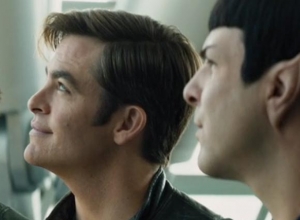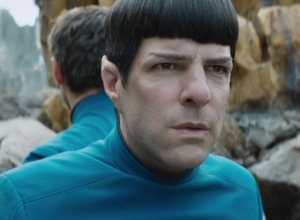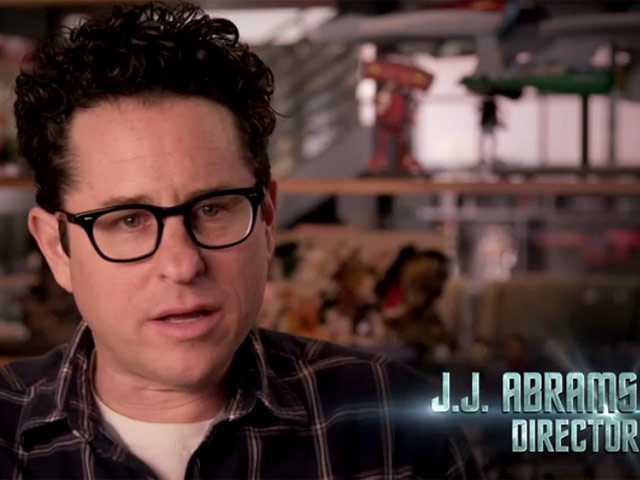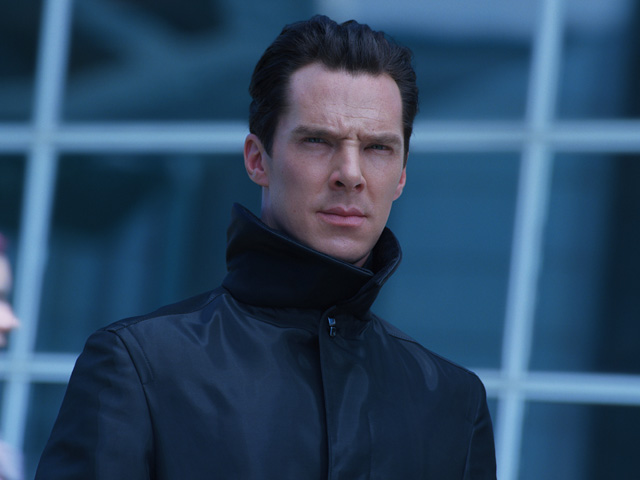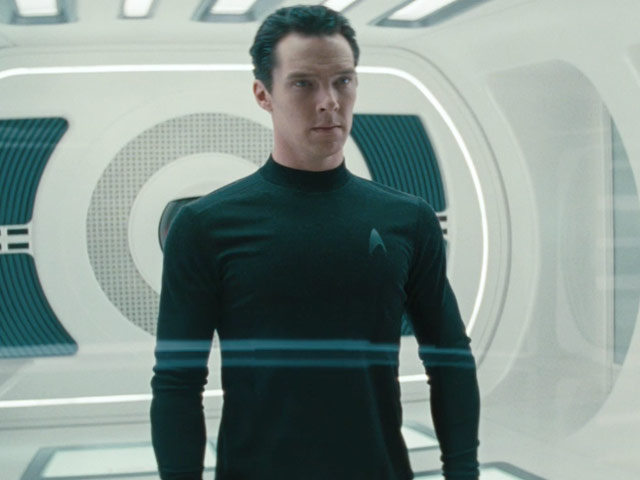| ABOUT THE PRODUCTION “Star Trek Nemesis” began principal photography on November 26, 2001, in California’s Mojave Desert, not far from Edwards Air Force Base, and wrapped on March 7, 2002, in Los Angeles. By starting with the desert scenes—Captain Picard driving an Argo, a 24th century off-road vehicle—Stuart Baird established the rapid pace of the action that was to come. Weeks before the scenes were filmed, Stewart had practiced driving the vehicle in a quarry. “It was extremely powerful, and I got a lot of pleasure out of driving it,” says the actor, who, when it came time to go in front of the cameras, made full use of his training, and did more than 90 percent of the driving required for the spectacular chase scene. At the conclusion of the sequence, the production returned to Los Angeles and Paramount Studios, where the entire cast experienced an eerie sense of dejá vu. For Stewart, the reunion “had a slightly unnerving feeling, in a kind of Rip Van Winkle way.” LeVar Burton, who returns as Geordi La Forge, agrees: “It was spooky replaying my character, but in a good way. Every time the cast comes back together, we pick it up as if we all were doing this the previous day, as opposed to, in this case, three years ago.” “As we were filming in the corridors of the Enterprise,” recalls Jonathan Frakes, “I looked over and saw Patrick, Brent, Marina and LeVar. It was as if time had stopped and the same kibitzing that we’ve all cherished over the years was going on. I loved seeing my old friends again, and it was nice to meet some new friends as well.” Those new friends included actor Tom Hardy, who was eager to join the ranks of Star Trek’s infamous villains. “Shinzon is a dynamic, young, bitter, helpless individual who comes to battle the man he was supposed to be . . . the man he felt he deserved to be,” Hardy observes of his character. “He’s torn between all he knows, based on his past, and what he believes he has the potential to be, in the form of Picard. As an actor, I found a human soul within the character and that made him a very interesting villain.” Casting Shinzon proved to be a demanding task for the filmmakers. Not only did the person portraying him have to be a competent enough actor to hold his own opposite Patrick Stewart, but he also had to look enough like Stewart so that the audience would buy him as both a dead-ringer of Picard and a younger version of him, too. “It’s not easy to find an actor who can inhabit the technical demands of such a role, while also having to look like someone else,” says Stewart, who had nothing but praise for Hardy’s performance. “Tom came through splendidly.” While Hardy bore a resemblance to Stewart, some adjustments had to be made to his appearance, and that’s when makeup designer Michael Westmore worked his magic. “Since Tom doesn’t have a cleft in his chin and because his nose is quite different, I had to sculpt a latex nose and chin for him,” says Westmore. “And, of course, I shaved his head. When the two of them did profile shots, or when they were in scenes together, there was definitely a feeling of a relationship between them, but they weren’t identical.” The process of turning Hardy into a Stewart lookalike took a couple of hours each day before shooting, but Hardy wasn’t alone during those long makeup sessions. Veteran Star Trek cast members Brent Spiner and Michael Dorn, who were daily transformed into their respective characters, Data and Worf, spent hours having their makeup done just as they had during their seven seasons on the television series and the three previous feature films. Also joining Hardy, Spiner and Dorn in the makeup chair was Ron Perlman, who was no stranger to prosthetics, having spent three seasons as the star of the popular television series “Beauty and the Beast.” His transformation into the Reman Viceroy took two-and-a-half hours. “My character is the power behind the power, a little like Shakespeare’s character Iago,” Perlman says. “The Reman Viceroy is shrouded in mystery, so the particular challenge was to portray him in a minimal, selective way, rooted in stillness. That’s a cool thing for an actor to wrap his teeth around.” Because Perlman’s character is an alien species audiences have never seen before, the actor had the luxury of taking risks with the role, and makeup designer Michael Westmore had unlimited possibilities in creating the look of the evil Reman Viceroy. “Remans live on a planet that gets sunlight only a fraction of the time,” Westmore notes, “so the filmmakers wanted them to have an almost Nosferatu look about them without making them into vampires.” As for the Reman ship, the Scimitar, which is three times as large as the Enterprise, production designer Herman Zimmerman took his design cue from a breastplate that costume designer Bob Ringwood fashioned for the Remans. “I extrapolated that breastplate into the cross bracing I used to build the ship,” explains Zimmerman. “Then the same design motif carried itself through everything until it eventually circled back to the wardrobe department in the form of belt buckles for the Reman uniforms.” Such rippling of ideas doesn’t surprise producer Rick Berman. “Over the course of 15 years we’ve put together a family of people, so we communicate in our own kind of shorthand,” says Berman. “As a result, we avoid that period when everyone has to adjust to one another’s style of work.” As the production wrapped, director Stuart Baird was satisfied that the arduous journey he had undertaken was well worth the trip. “Everyone involved with the film was very generous in sharing his or her vast experience,” he says. “In the end, I feel we produced a film that will be appreciated by loyal Star Trek fans, and I also think we’ll give those who have never experienced a Star Trek movie an exciting introduction to a wonderful new universe.” ABOUT THE FILMMAKERS STUART BAIRD (Director) first made his mark in the motion picture industry as one of the top editors in the business with his first editing credit being the rock opera “Tommy,” directed by Ken Russell. He followed that with the first of many collaborations with director Richard Donner, editing such films as “Lethal Weapon,” “The Omen,” “Maverick” and “Superman,” for which he garnered an Academy Award® nomination. He later nomination for his editing work on “Gorillas in the?received a second Oscar Mist,” directed by Michael Apted. Baird’s other editing credits include “Valentino,” “Outland,” “Superman II,” “Lethal Weapon 2,” “The Last Boy Scout,” “Demolition Man” and many others. Baird made the transition from editing room to director’s chair with the 1996 action thriller “Executive Decision,” starring Kurt Russell and Steven Seagal. He followed that with “U.S. Marshals,” starring Tommy Lee Jones and Wesley Snipes. RICK BERMAN (Producer/Story) has been involved with the Star Trek franchise since he was tapped by its creator Gene Roddenberry in 1986 to be a writer and co-executive producer for “Star Trek: The Next Generation.” He later rose to the position of executive producer of the popular series, which collected 55 Emmy nominations and 16 Emmys in its seven seasons. Berman went on to co-create and executive produce the next two series, “Star Trek: Deep Space Nine” and “Star Trek: Voyager,” and to produce the three “Next Generation” feature films, “Generations,” “First Contact” and “Insurrection.” In 2001, Berman launched the latest rocket in the Star Trek sky, “Enterprise,” a show he executive produces and for which he continues to write. Berman joined Paramount in 1984 as Director of Current Programming, and was responsible for overseeing such hit series as “Cheers,” “Family Ties” and “Webster.” Soon thereafter, he was named Executive Director of Dramatic Programming, overseeing the epic miniseries “Space,” as well as “Wallenberg: A Hero’s Story” and “MacGyver.” In 1986, prior to his association with Roddenberry, Berman was promoted to Vice President, Longform and Special Projects for Paramount Network Television, overseeing the development of telefilms, miniseries and specials. Today, he continues to be active in every aspect of the “Star Trek” properties, and even serves as a creative consultant for the Las Vegas Hilton’s Star Trek: The Experience attraction. JOHN LOGAN (Screenwriter) was nominated for both the American and British Academy Awards® for his screenplay of the Oscar®-winning drama, “Gladiator.” He was nominated for an Emmy and won a Writers Guild Award for his teleplay “RKO 281,” the HBO drama about the making of “Citizen Kane.” A self-professed Star Trek fanatic, Logan’s other screenplay work includes “Any Given Sunday,” “The Time Machine” and the new Tom Cruise movie “The Last Samurai.” Logan is currently working on a pair of film biographies: Abraham Lincoln for Steven Spielberg and Howard Hughes for Martin Scorsese. He is also working with director Ridley Scott on a sequel to “Gladiator.” MARTY HORNSTEIN (Executive Producer) worked as both executive producer and unit production manager on “Star Trek: Insurrection” and “Star Trek: First Contact.” He was also the co-producer and unit production manager of “Star Trek VI: The Undiscovered Country.” In 2001, Hornstein executive-produced the thriller “Along Came a Spider,” starring Morgan Freeman, and before that he executive-produced “Permanent Record,” produced “One on One,” “The Night Before” and “The Women’s Club,” and line-produced “The Perfect Weapon,” “Show of Force” and “Back to the Beach.” His credits as a production manager include “Beverly Hills Cop III,” “Drop Zone,” “Future World,” “Ode to Billy Joe,” “Cornbread, Earl and Me” and “Silent Running.” Hornstein was senior vice president of production for Kings Road Entertainment for two years, and served on the faculty of the American Film Institute from 1976 to 1983. JEFFREY L. KIMBALL (Director of Photography) joins the world of Star Trek after having lensed such box office hits as “Mission: Impossible 2,” “Wild Things,” “The Specialist,” “True Romance,” “Beverly Hills Cop II” and “Top Gun,” among many others. Recently, Kimball reunited with “Mission: Impossible 2” director John Woo for “Windtalkers,” starring Nicholas Cage. HERMAN ZIMMERMAN (Production Designer) has been an invaluable part of the Star Trek productions since 1987, when he designed the television series “Star Trek: The Next Generation.” He followed that with the series “Deep Space Nine” and is currently involved with “Enterprise.” He began working on the feature films with “Star Trek V: The Final Frontier” and has designed each successive production. Zimmerman’s other feature film credits include “Black Rain,” “One Crazy Summer” and “Better Off Dead.” His television work includes the series “Sons and Daughters,” “Ferris Bueller,” “Cheers,” “Webster” and “Down and Out in Beverly Hills,” and the television movies “The Word,” “So Proudly We Hail,” “The Burning Bed,” “Silence of the Heart” and “A Rumor of War.” Before coming to Los Angeles, Zimmerman served as associate professor of drama at Northwestern University, where he was scene designer and technical director of University Theater. DALLAS PUETT (Editor) previously worked with director Stuart Baird as the editor of Baird’s directorial debut film “Executive Decision.” Puett’s additional film credits include “Lara Croft: Tomb Raider,” “Lethal Weapon 4,” “Deep Blue Sea,” “Free Willy 2,” “Radio Flyer” and “Bird on a Wire.” BOB RINGWOOD (Costume Designer) redefined the look of the costumed hero with his innovative design for “Batman.” Years later, he redesigned his famous Bat suit for the film “Batman Forever.” His other credits include “A.I.: Artificial Intelligence,” “The Time Machine,” “Alien: Resurrection,” “Demolition Man” and “Excalibur,” among many others. PETER LAURITSON (Co-Producer) served as co-producer of “Star Trek: Generations,” “Star Trek: First Contact” and “Star Trek: Insurrection,” as well as producing the series “Star Trek: The Next Generation,” “Star Trek: Deep Space Nine,” “Star Trek: Voyager” and currently, “Enterprise.” On both the films and television series, Lauritson has overseen special visual effects, continuously exploring the limits while employing newer and newer technologies in this area, including digital effects. Prior to joining “Star Trek: The Next Generation,” Lauritson spent eight years overseeing Paramount Television’s Post-Production Department. MICHAEL WESTMORE (Makeup Designer/Supervisor) received an Academy Award® for his work on the film “Mask” and has also won nine Emmys. Two of those awards were for his work on the series “Star Trek: The Next Generation,” two more for “Star Trek: Deep Space Nine” and one for “Star Trek: Voyager.” He is currently involved in his fourth “Star Trek” series, “Enterprise.” Continually being recognized for his makeup designs, Westmore nominations for his work on “2010,” “The Clan of the?has also received Oscar Cave Bear” and “Star Trek: First Contact,” and he earned his additional Emmys for “Amazing Stories,” “Why Me?” and “Eleanor and Franklin.” Westmore’s numerous film credits include the three “Star Trek: The Next Generation” features, “Generations,” “First Contact” and “Insurrection,” as well as “Johnny Handsome,” “Iceman,” “Blade Runner,” “Raging Bull,” “New York, New York,” “The Andromeda Strain,” “The List of Adrian Messenger” and four of the five “Rocky” films. Westmore is a graduate of the University of California at Santa Barbara and the author of The Art of Theatrical Makeup for Stage and Screen, and the co-author (with J. Nazarro) of Star Trek: The Next Generation Makeup Effects Journal. He has also written many articles for medical and professional publications and is a featured lecturer worldwide, speaking not only about Star Trek, but also about makeup techniques for both corrective and medical applications. TERRY FRAZEE (Special Effects Coordinator) began his career in the 1960s under the tutelage of his father, Academy Award®-winning special effects artist Logan Frazee, on such television shows as “Gilligan’s Island” and “The Wild, Wild West.” In his ten years in television, the younger Frazee worked on shows such as “Hardcastle and McCormick,” “Hunter,” “Riptide” and “Stingray.” He also ran the Special Effects department for Stephen J. Cannell Productions for five years. Frazee later moved into feature film work, amassing credits that include “Star Trek VI: The Undiscovered Country,” “Star Trek: Generations,” “Star Trek: First Contact,” “Star Trek: Insurrection,” “Air Force One,” “The Postman,” “Blade Runner,” “A Few Good Men,” “No Way Out,” “Judgment Night,” “Eraser,” “Heat,” “Strange Days,” “Hocus Pocus,” “Point Break” and “Ghost.” MARK FORKER (Visual Effects Supervisor) has over twenty years of diverse experience in the field of visual effects and post-production. Prior to working on “Star Trek: Nemesis,” he supervised a signature visual effects -winning “The Lord of the Rings: The Fellowship?sequence for the Academy Award of the Ring.” He was also involved in creating photo-realistic environmental effects for “Stormrider,” Disney Theme Park Productions’ most ambitious large-format film attraction to date. Forker’s other credits include digital - winning “Titanic” and he?effects supervisor on James Cameron’s Academy Award -nominated “Apollo 13” as well?was lead compositor on Ron Howard’s Academy Award as on “Kundun,” “Armageddon” and “Waterworld.” Prior to joining Digital Domain in 1994, Forker acted as co-visual effects supervisor for Julie Taymor’s “Hop Frog,” an Edgar Allan Poe feature film project. He also lent his talent as FX compositor/director for REBO High Definition Studios in New York. In addition to effects work on children’s animated specials, commercials, music videos and film originated featurettes, Forker directed various shorts for the Japanese High Definition Television market. JERRY GOLDSMITH (Composer), after a half century composing music, has garnered 18 Academy Award® nominations including an Oscar® win for his haunting score in “The Omen,” three Emmy Awards, nine Golden Globe nominations and four British Academy Award nominations. One of cinema’s preeminent composers, Goldsmith has over 250 movies, television shows (including the theme from “The Man from U.N.C.L.E.”) and radio plays to his credit. He began his career at CBS Radio before being hired by the legendary Alfred Newman for the film, “Lonely are the Brave.” Goldsmith’s body of work includes the scores for Disney’s “Mulan,” which won him an Annie Award for Animated Features, “L.A. Confidential,” “Basic Instinct,” “Hoosiers,” “Under Fire,” “Poltergeist,” the memorable theme from “Star Trek: The Motion Picture,” “The Boys from Brazil,” “The Wind and the Lion,” “Chinatown,” “Papillon,” “Patton,” “Planet of the Apes,” “The Sand Pebbles” and “A Patch of Blue.” Goldsmith also received an Achievement Award at the 1998 Palm Springs International Film Festival, and three Saturn Award nominations from the Academy of Science Fiction, Horror & Fantasy. Release Date: 3rd Jan 2003 Distributor: UIP Cert: TBC Running Time: TBC www.startrek.com |


